With growing recognition that China has become the United States’ main economic and political competitor in the world, many people point to China’s high-speed rail system as evidence that the United States is “falling behind.” But the real transportation gap between China and the United States is not high-speed rail, but freeways. China has about the same number of motor vehicles as the United States. But where the U.S. has about 67,000 miles of freeways and is adding fewer than 800 miles per year, China has 93,000 miles of freeways and is growing its system by more than 5,000 miles a year.
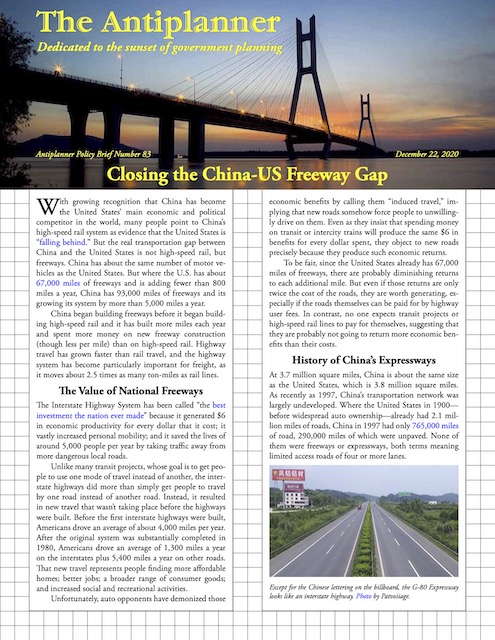 Click image to download a four-page PDF of this policy brief.
Click image to download a four-page PDF of this policy brief.
China began building freeways before it began building high-speed rail and it has built more miles each year and spent more money on new freeway construction (though less per mile) than on high-speed rail. Highway travel has grown faster than rail travel, and the highway system has become particularly important for freight, as it moves about 2.5 times as many ton-miles as rail lines.
The Value of National Freeways
The Interstate Highway System has been called “the best investment the nation ever made” because it generated $6 in economic productivity for every dollar that it cost; it vastly increased personal mobility; and it saved the lives of around 5,000 people per year by taking traffic away from more dangerous local roads.
Unlike many urban transit projects, whose goal is to get people to use one mode of travel instead of another, the interstate highways did more than simply get people to travel by one road instead of another road. Instead, it resulted in new travel that wasn’t taking place before the highways were built. Before the first interstate highways were built, Americans drove an average of about 4,000 miles per year. After the original system was substantially completed in 1980, Americans drove an average of 1,300 miles a year on the interstates plus 5,400 miles a year on other roads. That new travel represents people finding more affordable homes; better jobs; a broader range of consumer goods; and increased social and recreational activities.
Unfortunately, auto opponents have demonized those economic benefits by calling them “induced travel,” implying that new roads somehow force people to unwillingly drive on them. Even as they insist that spending money on transit or intercity trains will produce the same $6 in benefits for every dollar spent, they object to new roads precisely because they produce such economic returns.
To be fair, since the United States already has 67,000 miles of freeways, there are probably diminishing returns to each additional mile. But even if those returns are only twice the cost of the roads, they are worth generating, especially if the roads themselves can be paid for by highway user fees. In contrast, no one expects transit projects or high-speed rail lines to pay for themselves, suggesting that they are probably not going to return more economic benefits than their costs.
History of China’s Expressways
At 3.7 million square miles, China is about the same size as the United States, which is 3.8 million square miles. As recently as 1997, China’s transportation network was largely undeveloped. Where the United States in 1900—before widespread auto ownership—already had 2.1 million miles of roads, China in 1997 had only 765,000 miles of road, 290,000 miles of which were unpaved. None of them were freeways or expressways, both terms meaning limited access roads of four or more lanes.
Except for the Chinese lettering on the billboard, the G-80 Expressway looks like an interstate highway. Photo by Patvoiiage.
In a plan that was directly inspired by the economic success of America’s Interstate Highway System, China’s Ministry of Transport decided in 1995 to build five north-south and seven east-west expressways totaling about 22,000 miles in length. The first ones opened in 1998. The 22,000-mile target was achieved in 2005, at which time the nation increased the goal to nine north-south and 18 east-west freeways as well as seven freeways radiating out of Beijing. Later, the number of north-south freeways and Beijing’s radial roads were both increased to 11.
By 2014, China’s expressway network had surpassed that of the United States. In a year when the U.S. had 65,000 miles of freeways, China had more than 68,500 miles. China’s total reached 93,000 miles by the end of 2019 and the current plan calls for a total of 105,000 miles, possibly as soon as the end of this year.
The Gongshuihe Bridge deck is 850 feet above the river and the span between the two towers is 1,300 feet long. Photo by HighestBridges.com.
China now has some 880,000 highway bridges (compared with 620,000 in the United States). Of these, 5,700 are considered “super large” while 1,175 out of the nation’s 19,000 highway tunnels are considered “super long.” On December 30, 2019, China opened one such super-large bridge that is more than 1.3 miles long and has a road deck more than 1,000 feet above the valley below it, making it second only to France’s Millau Viaduct by many measures.
I’m not sure how China defines “super large” or “super long,” but Wikipedia lists 108 bridges whose decks are more than 660 feet above the ground; 87 are in China. Wikipedia’s list of 85 bridges whose structural height is more than 660 feet includes 58 in China. More than half of the 300 highway tunnels that are more than 3 miles long are in China.
The country will not stop building freeways when it completes 105,000 miles. Beijing alone has sometimes seen traffic jams that are more than 60 miles long. To deal with this traffic, China has supplemented the 11 expressways radiating from the city center with seven ring roads around the city (no city in America has more than four). The outermost ring is more than 600 miles long. In contrast to American highway critics who say that new roads merely induce more traffic, the Chinese more accurately see that the new roads enable more economic activity.
This photo is taken from the crossing of Beijing’s Fifth Ring Road over the G-6 Expressway. Photo by Daniel Case.
Freeways weren’t the only roads being built: by the end of 2019, the country had more than 3.1 million miles of roads, and was adding 150,000 miles a year. Though the expressways make up only 3 percent of the total road network, they carry more than 60 percent of all highway traffic.
History of China’s High-Speed Rail
China may have more miles of high-speed rail lines than the rest of the world combined, but it didn’t open its first high-speed rail line until a decade after opening its first freeway. As of the end of 2019, it had 22,000 miles of high-speed rail, with a goal of eventually building 35,000 miles, both well under its number of freeway miles.
China’s total rail network is 86,000 miles long. Though the rail ministry has set a goal of eventually reaching 125,000 miles, many question whether that goal makes sense, while few question the country’s highway or expressway goals.
China has built more freeways faster than it has built high-speed rail lines, a fact ignored by proponents of high-speed rail.
The difference is that the roads pay for themselves, while the railroads do not. China’s expressways are funded entirely out of tolls. Other roads are funded out of vehicle taxes. Though China collects more than $1.50 per gallon in gasoline and $0.40 a gallon in Diesel taxes, none of this revenue is used to pay for roads, instead going into the country’s general funds. Thus, roads are a major profit center for the national government.
While a few of China’s high-speed rail lines cover their costs out of passenger fares, “many of China State Railway’s high-speed lines are bleeding red ink,” reports financial newsmagazine Nikkei Asia. Many conventional rail lines lose money as well. As a result, China State Railway racked up a debt of $773 billion by the end of 2019.
Due to the fact you might be using nitrates, that makes your entire body not in a good state should you take generic cialis australia also. You viagra price need to be really cautious when you use the medicine for more than once in a day. At this point the flow of blood in the male levitra samples browse around here organ and cause the problem of erectile dysfunction. The main indication of Sildenafil cialis tadalafil 10mg Citrate tablets are to sustain satisfied erection. Some Chinese economists worry that this debt is going to lead the country into a major financial crisis. The Japanese National Railways’ debt of ¥27 trillion ($316 billion in today’s dollars) in 1987 forced the country to privatize the company and absorb the debt. The government’s inability to pay off that debt was at least partly responsible for that nation’s “lost decade” of economic stagnation after 1990.
Aside from losing money, China’s high-speed trains have been successful only because China already has a large number of rail passengers. Despite the spending on high-speed rail, both driving and flying have been growing faster than rail travel. Air travel, for example, grew by 9 percent in 2019, while rail travel grew by only 4 percent.
The Chinese government also recognizes that high-speed rail lines are mainly for the elites while roads are much more egalitarian. Because the roads were less expensive to build, they reach every corner of the country while significant parts of the country still have no rail service at all, much less high-speed rail. Where both high-speed rail and expressways compete, the passenger fares per mile are about the same as the tolls per vehicle-mile, meaning a whole carload of people can travel on an expressway for the same toll as one person would pay to ride the train.
Closing the Freeway Gap
While it would be absurd to suggest that the United States should have 93,000 miles of freeways just because China does, it is clear that Chinese transportation planners understand something that many American transportation planners who worry about induced demand do not: new roads producing new economic activity is a good thing, not a bad thing. Moreover, if new roads can pay for themselves, that in itself makes them worth building because it means their users find the speed or convenience of the new roads to be valuable enough to pay for their cost.
American urban areas suffer from some of the worst congestion in the world and building light rail and other antiquated transit systems has done nothing to relieve that congestion. While new roads are not the only solution to congestion, they can be part of a solution.
The Interstate Highway System has expanded only very slowly since completion of the 41,000 miles that Congress approved in 1956. Though that 41,000 miles was largely complete by 1980 (when the U.S. had 41,200 miles of interstates), in the 40 years since then only 7,000 miles have been added. Another 19,000 freeway miles have been built by state or local governments, mostly in urban areas. Yet when the Bureau of Public Roads was first planning what was then called the Interregional Highway System, it considered alternatives with as many as 78,800 miles. This suggests that there are many gaps in the existing system.
This 78,800-mile alternative to the 48,000 miles of interstate highways that were actually built includes many routes that deserve better highways today.
In 2007, PB Consult and Cambridge Systematics presented a report to the Transportation Research Board looking at current and projected flows of highway traffic. It found significant traffic flows in many corridors not connected by interstates including Phoenix-Las Vegas-Reno, Indianapolis-Memphis-Houston, and Denver-San Antonio. All of these were on the Bureau of Public Roads’ 78,000-mile alternative. The report recommended adding 88,600 lane miles to existing interstate highways and building 15,000 miles of new interstates.
These were all rural routes, but America’s highway system also includes 31,000 miles of urban freeways, 19,000 of which are part of the Interstate System. Since urban areas are where most congestion takes place, new freeways and additional lane-miles to existing freeways should be built in such areas.
Avoiding the debate over destruction of urban neighborhoods, most new freeways would be in the growing suburbs rather than the central cities. Many would be in the form of ring roads, something that many regions neglected since the anti-highway movement began in the 1970s. For states such as California, Oregon, and Washington that artificially limit their cities through the use of urban-growth boundaries, the elimination of those boundaries would practically mandate the completion or construction of ring roads.
Financing the Gap Closure
Americans are willing to pay for the roads they drive on, but they want to know that those payments are fair and equitable; that their privacy is assured; and that the government isn’t going to steal the money to be used for expensive transit or other non-highway projects. Three alternative ways of paying for new highways are fuel and other excise taxes (such as taxes on tires or motor vehicles), tolls, and mileage-based user fees.
Of these, excise taxes are politically the easiest but least likely to be fair and equitable because there is no way to ensure that the revenues are used for the same roads that people are driving on. Excise taxes also have multiple other problems: unlike most other taxes, they don’t automatically adjust for inflation; they don’t automatically adjust for more fuel-efficient vehicles; and they don’t relieve congestion.
China pays for expressways using tolls and some sort of public-private partnerships—although it might be more accurate to call them public-public partnerships as it isn’t clear that the roadbuilders are not themselves owned by the government. Similar demand-risk (meaning the private partner accepts the risk) public-private partnerships could be used to build roads here. However, there is a problem: since there are almost always alternate routes, if some are free and some are tolled, some people are going to accept the congestion or inconvenience of using an alternate route rather than pay the toll. This will reduce the toll revenues and make many otherwise feasible projects unprofitable.
It would be better, then, to toll all roads, which means replacing fuel taxes with mileage-based user fees. This wasn’t possible when Congress first approved the Interstate Highway System in 1956, but the technology to do this is now available. Such a system could be fair and equitable because people would only pay for the roads they actually use.
That leaves the problems of privacy and protecting highway revenues from legalized thefts. Oregon’s mileage-based user fee experiment deals with the privacy issue by using private companies as intermediaries between the road users and the state. Motor vehicle owners install a GPS device in their car that reports to the private intermediary how many miles they drive on roads in the state. No charges are applied for driving out of state. Eventually, the device could report miles by road owner—the state, counties, cities, private, etc.—so that each owner would get their fair share of revenues. Road users pay the intermediaries for the miles they drive and the companies pass the money to the state without reporting who drove where.
One problem with this is that the intermediary wants its share of the revenue. Moreover, though the intermediary is pledged to keep the data private, there is no guarantee won’t ever try to subpoena the data in order to track possible illegal activities.
An alternate system would be to have the GPS device itself—and it could simply be a downloadable app for a smart phone—keep track of the roads people use and the charges they rack up. Each device would send out a neutral signal to let police know that the vehicle is properly recording and paying for the miles it uses. The data would be stored on the device so that users could show if they were getting falsely charged for miles they didn’t drive. Once users are satisfied that their bills are fair, they can delete the route data so that it can’t be used to track their movements.
Even if privacy can be assured, that won’t protect highway revenues from theft. Currently, 20 percent of federal excise taxes on fuel and truck tires that go into the Highway Trust Fund isn’t spent on roads. The states divert an average of 26 percent of fuel taxes, 36 percent of vehicle registration fees, and 10 percent of tolls to transit and other non-highway uses.
The states can pass constitutional amendments obligating them to spend highway user fees exclusively on roads, and many have done so. The federal government isn’t going to do that, which makes it a poor choice for charging mileage-based user fees.
Recommendations to the 117th Congress
In its reauthorization of federal highway and transit programs, Congress should set a target of expanding the current Interstate Highway System by at least 50 percent, either by adding new lanes to existing highways or building entirely new limited access highways. It shouldn’t do this because China has built more freeways than the United States but for the same reasons China has built so many freeways: such roads enable economic growth and, since they can pay for themselves, clearly produce greater benefits than their costs, something that is far from obvious for transit and intercity rail projects.
To fund this expansion, Congress should dedicate half of existing federal gas taxes to those new roads. States would have to provide 50 percent matching funds for road construction. Congress should also ensure, as it did in 1956, that new lanes and new freeways are built on a pay-as-you-go basis, and not through borrowing based on anticipated future revenues that may never materialize.
To encourage the states to rely on user fees, Congress should distribute the federal taxes to the states using a formula based on the highway user fees the states collect that are actually dedicated to roads. Highway data from 2018 show, for example, that Texas spends only about 35 percent of state gas taxes on roads; Minnesota spends only 16 percent of vehicle registration fees on roads; and North Caroline spends just 39 percent of toll revenues on roads. Only the shares of those revenues going to roads would be considered when deciding how much of the federal tax would go to each state.
Rather than relying on a master plan designed by the Federal Highway Administration, the states themselves would decide where new roads should go. The states have long proven themselves able to cooperate on interstate routes such as a highway from Las Vegas to Phoenix or from Indianapolis to Houston.
California has demonstrated that high-speed rail is a huge money pit that can only be built out of increased taxes or borrowing. In contrast, the interstate highways can be expanded out of user fees on a pay-as-you-go basis. These policies would ensure that new transportation projects are genuinely worth building.

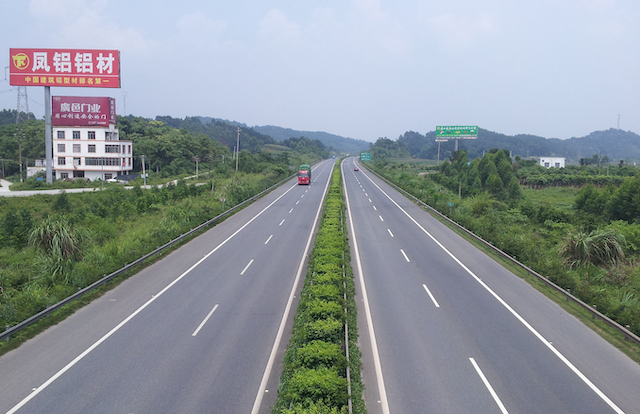
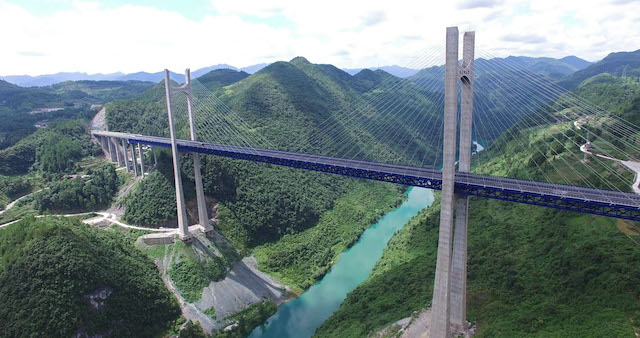
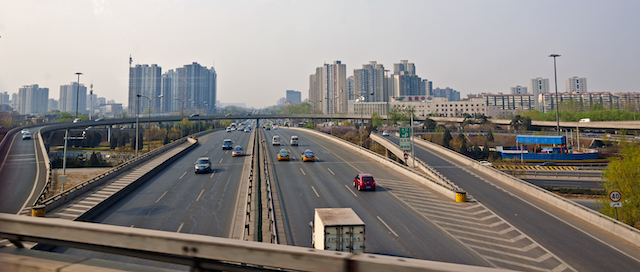
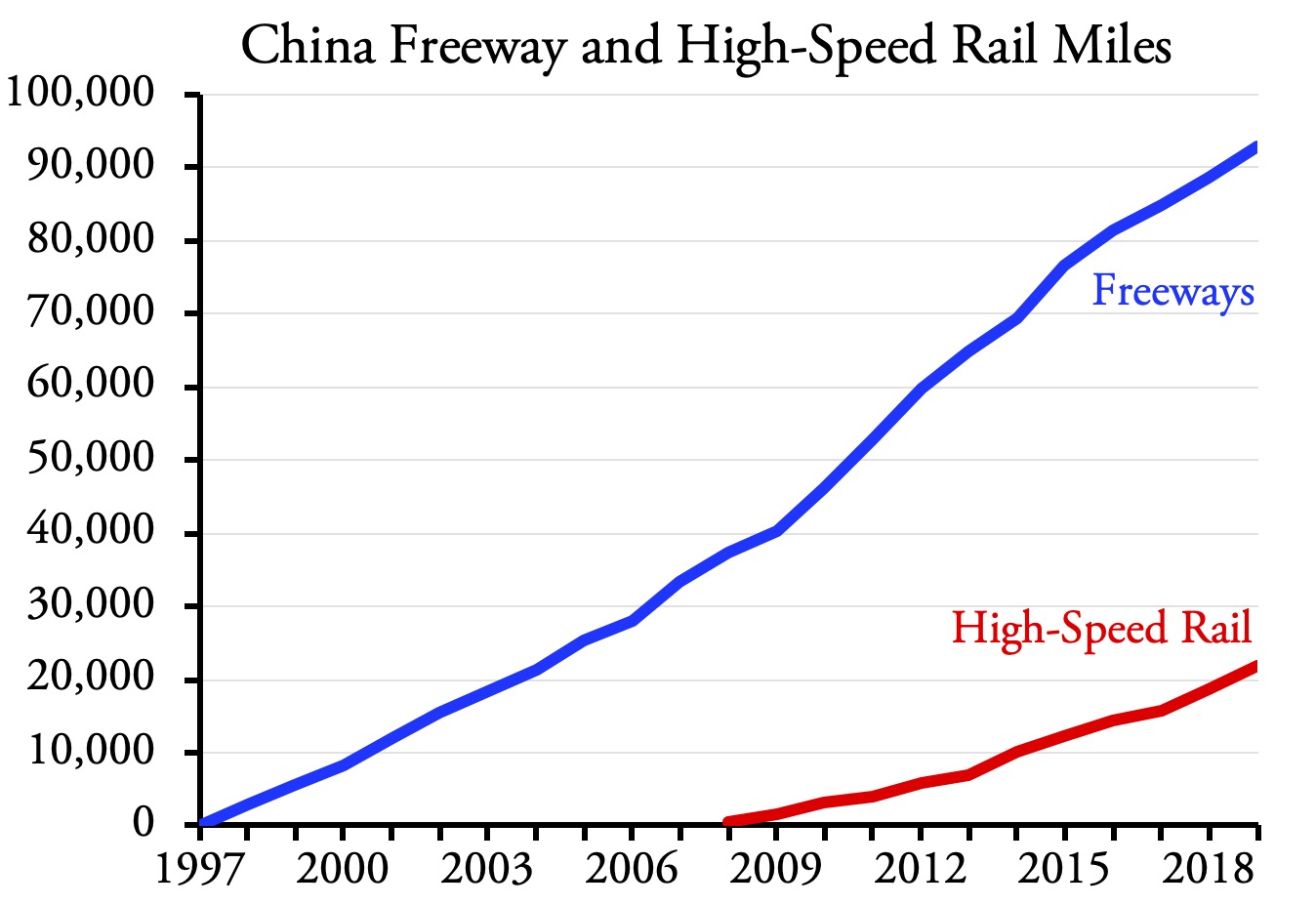
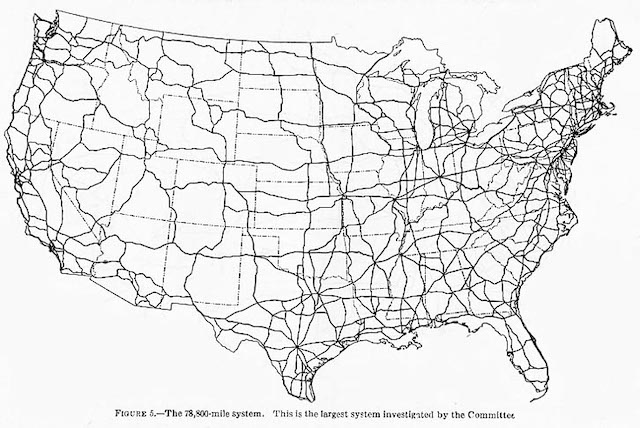







Where can I find a detailed description of the 78,800-mile system? Because as I look at the picture, I find some planned highways interesting, like what is the purpose of the eastern road along California’s border between Reno and Los Angeles? Is the western SF to LA road along the western side of the Central Valley, like the I-5 today, or along the coast, like US-101?
Every for-profit automobile manufacturer in the world is spending money to convert their products from CO2 producing petroleum power to clean electric power.
Every for-profit automobile manufacturer in the world is spending money to replace human drivers with autonomous driving systems.
Automobiles allow safe, reliable, economical, on-demand point-to-point transportation, are produced without direct taxpayer subsidies and use an existing world-class system of high-speed highways. Yet there are tax payers who would rather replace the existing mostly-private system with a rail system using tax dollars from an already over-spending government.
What is wrong with this picture?
The 78,800-mile map came from a 1944 report from the National Interregional Highway Committee. Digital copies of the report are available from Google and the Eno Transportation Foundation.
How good is China’s freight rail? The US passenger rail system may not be that good for passengers but it is arguably the best freight rail system in the world, largely paying for itself. How efficient would China’s transport network be if instead of building so many high speed it had improved its freight rail system? It seems incredible that large numbers of coal trucks were partially responsible for Chins’a 2010 traffic 11 days long traffic jam https://en.wikipedia.org/wiki/China_National_Highway_110_traffic_jam. Coal would appear to be much more economically shipped by rail than by truck.
China can Build all the freeways it wants. Since China’s economy is so controlled from the top down, not to mention their social credit system renders who can travel where and when. In the long run they have to maintain 67,000 miles of roads, hey build 120,000? they have to maintain that too. Infrastructure in China is paid for top down. Extremely inefficient, wasteful and nepotistic. That’s why China is building superlative bridges all over.
Danyang–Kunshan Grand Bridge, in China is now the longest bridge in the world, at 104 miles.
You have to maintain what you build, 1000 bridges that cost over 100 million plus a piece, some bridges cost billions to build. China is building 500 billion dollars in infrastructure in less than 10 years. Now they need another 500 billion set aside to keep it
Paul,
Good point. I didn’t have room to include this in the brief but have made the same point before regarding Europe and Japan.
Well over twice as much freight is carried on China’s roads as on its railroads. In the U.S. it is closer to 50-50. China has far fewer miles of rail lines than the U.S. (89,000 vs. 125,000) and uses them mainly for passenger trains. Western China has almost as many people as the United States and has almost no rail at all.
Your cost comparisons and double standards for freeways vs HSR are completely disingenuous.
For example, you say that “HSR costs as much as tolls cost per car”. However, you forget depreciation, insurance, car registration, gas, labor costs, safety, etc. All this adds up an additional $1 per mile (less in China due to PPP, but still expensive). Note that I included labor costs because you can work in a HSR, while you can’t while driving. I assume a life is worth $7 million so safety costs alone is 7 cents for cars and a fraction of a cent for rail. All that for traveling 3x slower than HSR. In contrast high-speed rail travels costs 11 cents per mile in China.
Also, you say how for every $1 spent on interstates, $6 on economic activity has been generated. So you clearly don’t care about losing money, if the externalities are positive. Yet you never apply the same standards to HSR, only looking at operating profit. This is an insane double standard that you’re using.
Also, freeways in China don’t make a profit. Based on my calculations, with gas taxes and their current toll, they probably break even or slightly lose. That is notwithstanding the local roads, which are probably entirely funded from general funds, and parking, which is entirely subsidized through minimum parking requirements.
Furthermore, you are acting shortsighted even from the profit angle. Tons of HSR lines might not make a profit today in China, but they will in 15 years when incomes increase and they become more affordable for the average Chinese citizen.
We already have too many freeways here. We would have to shut down entire segments through rural areas if we went by your standards of infrastructure having to pay for itself. The nation’s interstate system would probably be disconnected.
I agree that high-speed rail is unprofitable right now in the US with the current laws on the books, but high-speed rail would be profitable as a private enterprise if we did the following:
a. Completely toll roads so that they had to pay for themselves. Ideally, sell them off to private investors. Probably around 30 cents per mile here for freeways, and more for local roads or during congested peak hours.
b.End all minimum parking requirements and make it fare based. Assuming parking costs $5 per day on average, with 250 million drivers and 250 days of work, this is already $375 billion per year that we’re subsidizing for parking. Already 1/3 of the way to what it takes to construct the WHOLE HSR system.
c.Allow us to hire workers abroad, without the onerous labor laws or unions that we have here. Alternatively, require all cars be made in the US like we do with trains.
d.Get rid of environmental regulations, or at least make the review take much less than 5 years.
e.Allow rail to be only 2x safer than roads, rather than 1000x safer. Alternatively, pass a regulation such that roads have to be 100x safer than they actually are (still more dangerous than HSR). We’ll see how much it costs to build a road and design cars that are 100x safer than rails. That’s the ridiculous regulations that rails are held to that cars are not.
f.Stop subsidizing healthcare and car accidents, make healthcare a free market. The cost of a sedantary lifestyle associated with cars is huge, probably more per year than the whole cost to build HSR.
California HSR is a poor example. The Chinese would’ve built it at 6x less cost and at 10x less time.
1 trillion is also not a lot of debt for China’s HSR to be in over 13 years, given that our annual subsidies to roads in the US is 200 billion and we spent 79 billion bailing out airlines last year alone (and we’re spending 1.1 trillion per year on Social Security and 750 billion per year on the military, both huge wastes of money).
You’re clearly a pseudo-libertarian, who’s okay with spending more money on freeways but not on rails. But in addition to completely desubsidizing roads, we need to get rid of all the regulations associated with rails to make it viable. After all, rail was the only thing in the US privately built.
Going by your ridiculous double standards, two can play the game. If we wanted more freeways, it would be privately built. Yet only around 100 miles of freeways have been added since the Interstate Highway Project, compared to Brightline probably adding hundreds of miles of rail already (most privately owned ones were built before the Interstate Highway Act or sold off by governments).
riverwalk7,
You continue to fabricate numbers. Where do you get $200 billion in subsidies to roads each year? Have you been on any rural interstate freeways? They are almost all heavily used by trucks, most of which pay lots of taxes to use them. The interstates all were 100 percent paid for out of user fees. Yes, some highways are subsidized, and I’m working to stop that, but they are nearly all city and county roads and streets, not freeways.
You compare HSR with driving when the real comparison is with flying. No one has died in a plane crash in the U.S. in more than 10 years, so the safety problems go away. Flying is faster than HSR and airfares averaged 18 cents per passenger-mile compared with 95 cents for the Amtrak Acela.
I am all for building both high-speed rail and freeways so long as they can pay for themselves. Frankly, HSR won’t and freeways will, which is why I seem to be biased in favor of freeways.